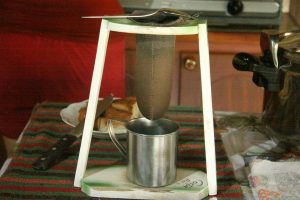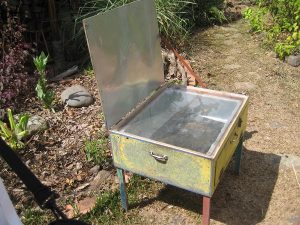Written by: Mark Wang
Being in America, you become accustomed to things that you view as a part of everyday life. Toilets, stoves, and kitchen appliances are all typical household items that one expects to see when they enter a house. But how is it different in Costa Rica? Americans might wander into a Costa Rican household and be puzzled at different items they might find. Here are a few!
Although seldom used and typically found in more sustainable households, this simple looking, wooden box is actually a solar cooker. It serves the same function as a stove, but uses solar power instead of gas. This is an inexpensive and useful alternative for gas stoves as it does not use up any fossil fuel and almost requires no labor to operate. The concept is very simple; you place the food you want cooked inside the box, angle the cooker so that the sun shines on the mirror, the mirror reflects the sun’s rays into the box heating up your meal. One drawback to this contraption is that it takes a longer time to cook than your average gas stove. It would take about 3 hours to cook a meal, whereas a gas stove would cook the same meal in less than 10 minutes.
 This next appliance (the one that looks like a dirty sock on display) is actually a coffee strainer. It consists of two parts: a strainer and a stand. The ground coffee beans are place into the strainer and a cup is placed underneath it. Hot water is then poured into the strainer, which drips into the cup. And there’s your coffee! If you want your coffee to be stronger, simply pour the contents of the cup back into the strainer once, twice, or three times, depending on how strong you want it to be. In America, we have coffee makers that can cost up to $200 dollars, while this strainer can be made for only $10 dollars. American coffee makers require electricity and may need to be repaired. The Costa Rican coffee strainer is a lot more practical, simple and FUN!
This next appliance (the one that looks like a dirty sock on display) is actually a coffee strainer. It consists of two parts: a strainer and a stand. The ground coffee beans are place into the strainer and a cup is placed underneath it. Hot water is then poured into the strainer, which drips into the cup. And there’s your coffee! If you want your coffee to be stronger, simply pour the contents of the cup back into the strainer once, twice, or three times, depending on how strong you want it to be. In America, we have coffee makers that can cost up to $200 dollars, while this strainer can be made for only $10 dollars. American coffee makers require electricity and may need to be repaired. The Costa Rican coffee strainer is a lot more practical, simple and FUN!
 As Americans, we’re used to seeing shiny porcelain thrones in our bathrooms inviting us to sit on them. But in Costa Rica, wooden boxes in the middle of the forest are everywhere. They are not as bad as one would think and they serve a very functional purpose. “Compost toilets”, as they are called, save the human waste for fertilizer that is later used on farms. The toilet is surrounded by 3 walls and is usually placed in such a way that the user can enjoy a nice view. You can add a half-cup of sawdust to cover the waste to assist in breaking down the process. While it may smell stinky and a few bugs may be seen lurking around, the compost toilet is sustainable in that it uses everything and leaves nothing to waste, literally.
As Americans, we’re used to seeing shiny porcelain thrones in our bathrooms inviting us to sit on them. But in Costa Rica, wooden boxes in the middle of the forest are everywhere. They are not as bad as one would think and they serve a very functional purpose. “Compost toilets”, as they are called, save the human waste for fertilizer that is later used on farms. The toilet is surrounded by 3 walls and is usually placed in such a way that the user can enjoy a nice view. You can add a half-cup of sawdust to cover the waste to assist in breaking down the process. While it may smell stinky and a few bugs may be seen lurking around, the compost toilet is sustainable in that it uses everything and leaves nothing to waste, literally.
One thing that I learned while being in Costa Rica and seeing these different “appliances” is that everything is built in its simplest form and serves its purpose. Nothing fancy is needed; if it gets the job done, then it’s used. Being on this trip has really showed me the excess of things that I have and how much of it isn’t necessary.

